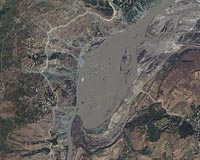| . |  |
. |
Phnom Penh (AFP) Nov 17, 2010 Cambodian Prime Minister Hun Sen dismissed concerns Wednesday that Chinese dams were responsible for the Mekong River's low water levels, telling environmentalists not to be "too extreme". Hun Sen blamed decades-low water levels in southeast Asia's longest river on "irregular rainfall" caused by global climate change. The so-called "Mighty Mekong" dropped to its lowest level in 50 years in northern Thailand and Laos earlier this year, alarming communities who depend on the waterway for food, transport, drinking water and irrigation. "That the Mekong River, or other rivers, have lower or higher levels of water depends on the rain," Hun Sen told reporters after a regional meeting with leaders from Thailand, Laos, Vietnam and Myanmar. "So please don't be too extreme about the environment and don't say hydropower dams cause water levels to drop in the lower Mekong. If you think that, it is a mistake." China has eight planned or existing dams on the Mekong River, and rejects activists' claims that these have contributed to low water-levels downstream. "There is no clear data-sharing from China on how they manage their Mekong dams, so they can still insist that they are not causing the problem," said Premrudee Daoroung from Bangkok-based environmental group TERRA. "However, looking at northern Thailand, we can see the hydrology change is very abnormal and it be will hard for people there to keep believing that it is not because of the dams," she told AFP. The Mekong River Commission (MRC) -- an intergovernmental advisory body representing Cambodia, Laos, Thailand and Vietnam -- is currently studying the possible construction of 11 hydropower projects on the lower Mekong river. Last month, the MRC released an influential report urging the four countries to delay any decisions about building dams for 10 years due to the many risks involved. Environmental groups have long objected to damming the river, arguing that it would damage fragile ecosystems. More than 60 million people rely in some way on the river, which is the world's largest inland fishery, producing an annual estimated catch of 3.9 million tonnes, according to the MRC.
Share This Article With Planet Earth
Related Links Water News - Science, Technology and Politics
 Uzbekistan warns of 'disaster' over Tajik plant
Uzbekistan warns of 'disaster' over Tajik plantTashkent (AFP) Nov 17, 2010 Uzbekistan Wednesday warned world powers of a looming environmental disaster from Tajikistan's plan to build a huge hydro-electric dam, in a new show of tensions from the ex-Soviet neighbours. Tashkent also accused Tajikistan's main aluminium plant, the largest in Central Asia and located near Uzbekistan's southern border, of causing increased fluorine-related diseases among the population a ... read more |
|
| The content herein, unless otherwise known to be public domain, are Copyright 1995-2010 - SpaceDaily. AFP and UPI Wire Stories are copyright Agence France-Presse and United Press International. ESA Portal Reports are copyright European Space Agency. All NASA sourced material is public domain. Additional copyrights may apply in whole or part to other bona fide parties. Advertising does not imply endorsement,agreement or approval of any opinions, statements or information provided by SpaceDaily on any Web page published or hosted by SpaceDaily. Privacy Statement |